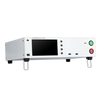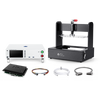The Wall Street Journal: Lessons Learned on Startups’ Shenzhen Tour
For the past few years, a flood of hardware startups based in Silicon Valley have been traveling to Shenzhen to find easier, better and less-costly ways to make products. Following six of those startups on a recent Shenzhen factory tour yielded some interesting trends and lessons:
1. More factories want startup business. With China’s economic slowdown and export slump, many factories that used to rely on big volume and low margin orders—and were reluctant to take smaller orders—are operating under capacity. “They want business from startups more than I expected,” says Chris Evdemon, a partner at a Beijing-based venture-capital firm, China’s Innovation Works. Mr. Evdemon runs the firm’s Silicon Valley office, which organized the trip for its portfolio companies
2. Shenzhen-based factories are opening shops in San Francisco so they can be close to startups. Blue Clover Devices, or BCD, a manufacturer that used to make electronic parts for Audi and Volkswagen, moved its U.S. office from Silicon Valley to San Francisco last year so it can work more closely with startups. Seeed Studio, which works with makers and hardware startups globally, opened an office there last year, too. These are pure-play manufacturers so they are different from accelerators such as PCH’s Highway1 and HAX, which invest and take stakes in startups they work with. These manufacturers are also different from the brokers many startups can find online. If they can make a product and the price is right, they will make it themselves.
3. Production prices are coming down because of competition and a more efficient ecosystem. Since more manufacturers are starting to work with startups, prices are getting competitive, says Pete Staples, BCD’s founder and president. Eric Pan, founder and chief executive of Seeed, says that while manufacturing costs have remained consistent, open-source hardware has significantly lowered the costs of research and development, engineering and testing. So the overall cost of first-batch production has come down. For example, once Seeed makes a circuit board, it keeps a copy of the design that can be used without charge by other customers. Seeed has served about two million customers and has a big library of open-source hardware. While a circuit board could cost 300 yuan ($45) three years ago, Mr. Pan says, it can cost as little as 60 yuan now.
4. Technology has made communications easier. Compology, a waste-management sensor startup that visited BCD on the tour and became a client shortly after, now goes to the manufacturer’s San Francisco office every Wednesday to hold a video conference with BCD’s Shenzhen team.
5. But that doesn’t mean startups can stop visiting Shenzhen. Jason Aramburu, founder of smart-garden-sensor startup Edyn, picked up a sample sensor from BCD during the Shenzhen trip. While he was happy with it overall, he noticed a dent on the plastic finish, something he might not be able to tell from looking at photos on his computer in San Francisco. Messrs. Pan and Evdemon recommend founders visit Shenzhen for an extended period to understand the ecosystem, component availability and engineering capability.
6. Intellectual-property protection has become better, but be careful. Shenzhen is known for its knockoffs, although Mr. Pan of Seeed says the government has become more serious about cracking down on piracies. The hardware boom has also reduced the appeal of big brands, and consumers are more receptive to original and innovative products made by smaller companies, he says. Mr. Staples warns that if a factory offers a deal that is too good, it is time to worry about IP. “They may want to extract something from you,” he says. “It’s important to make sure there’s an alignment of interest.”
7. Quality is getting better, too. Since the first iPhone launch in 2007, Apple quality has become the industry standard and what every company asks for, says Mr. Staples. Startups also care more about design and quality than previous small companies because of technology advancement, abundance of capital and competition.
8. Startup founders are younger and better at what they do. “We’re seeing people coming to Shenzhen right out of school,” says Mr. Staples. And they come with a lot of great ideas, skills and commitment to be successful, he says.
9. Still, factories don’t work with just anybody. While Seeed makes products from one unit to tens of thousands, most factories do have minimum volume requirements. BCD typically looks for revenue of half a million dollars in the first year on a new project, says Mr. Staples, still much lower than the $1 million industry standard.
10. Many Chinese venture-capital firms and technology companies are opening offices in the San Francisco Bay Area and want to use their China connections to attract high quality startups in the U.S. Meanwhile, Chinese e-commerce company JD.com and the Taobao marketplace of rival Alibaba operate crowdfunding and retail channels that can be appealing to U.S. startups. But be mindful of the Balkanization of the Chinese Internet when picking a Chinese partner, says Mr. Evdemon of China’s Innovation Works. “Normally, you can’t work with Alibaba, Tencent and Baidu at the same time,” he says.
11. Be safe. Before Shenzhen became the capital of global hardware manufacturing, it was a small fishing village bordering Hong Kong 35 years ago. Many things were built on shaky grounds in a speedy fashion. The recent instances of hoverboards bursting into flames and the massive landslide of construction waste are prominent examples of safety issues there. Keep your eyes open for bad safety practices.
1. More factories want startup business. With China’s economic slowdown and export slump, many factories that used to rely on big volume and low margin orders—and were reluctant to take smaller orders—are operating under capacity. “They want business from startups more than I expected,” says Chris Evdemon, a partner at a Beijing-based venture-capital firm, China’s Innovation Works. Mr. Evdemon runs the firm’s Silicon Valley office, which organized the trip for its portfolio companies
2. Shenzhen-based factories are opening shops in San Francisco so they can be close to startups. Blue Clover Devices, or BCD, a manufacturer that used to make electronic parts for Audi and Volkswagen, moved its U.S. office from Silicon Valley to San Francisco last year so it can work more closely with startups. Seeed Studio, which works with makers and hardware startups globally, opened an office there last year, too. These are pure-play manufacturers so they are different from accelerators such as PCH’s Highway1 and HAX, which invest and take stakes in startups they work with. These manufacturers are also different from the brokers many startups can find online. If they can make a product and the price is right, they will make it themselves.
3. Production prices are coming down because of competition and a more efficient ecosystem. Since more manufacturers are starting to work with startups, prices are getting competitive, says Pete Staples, BCD’s founder and president. Eric Pan, founder and chief executive of Seeed, says that while manufacturing costs have remained consistent, open-source hardware has significantly lowered the costs of research and development, engineering and testing. So the overall cost of first-batch production has come down. For example, once Seeed makes a circuit board, it keeps a copy of the design that can be used without charge by other customers. Seeed has served about two million customers and has a big library of open-source hardware. While a circuit board could cost 300 yuan ($45) three years ago, Mr. Pan says, it can cost as little as 60 yuan now.
4. Technology has made communications easier. Compology, a waste-management sensor startup that visited BCD on the tour and became a client shortly after, now goes to the manufacturer’s San Francisco office every Wednesday to hold a video conference with BCD’s Shenzhen team.
5. But that doesn’t mean startups can stop visiting Shenzhen. Jason Aramburu, founder of smart-garden-sensor startup Edyn, picked up a sample sensor from BCD during the Shenzhen trip. While he was happy with it overall, he noticed a dent on the plastic finish, something he might not be able to tell from looking at photos on his computer in San Francisco. Messrs. Pan and Evdemon recommend founders visit Shenzhen for an extended period to understand the ecosystem, component availability and engineering capability.
6. Intellectual-property protection has become better, but be careful. Shenzhen is known for its knockoffs, although Mr. Pan of Seeed says the government has become more serious about cracking down on piracies. The hardware boom has also reduced the appeal of big brands, and consumers are more receptive to original and innovative products made by smaller companies, he says. Mr. Staples warns that if a factory offers a deal that is too good, it is time to worry about IP. “They may want to extract something from you,” he says. “It’s important to make sure there’s an alignment of interest.”
7. Quality is getting better, too. Since the first iPhone launch in 2007, Apple quality has become the industry standard and what every company asks for, says Mr. Staples. Startups also care more about design and quality than previous small companies because of technology advancement, abundance of capital and competition.
8. Startup founders are younger and better at what they do. “We’re seeing people coming to Shenzhen right out of school,” says Mr. Staples. And they come with a lot of great ideas, skills and commitment to be successful, he says.
9. Still, factories don’t work with just anybody. While Seeed makes products from one unit to tens of thousands, most factories do have minimum volume requirements. BCD typically looks for revenue of half a million dollars in the first year on a new project, says Mr. Staples, still much lower than the $1 million industry standard.
10. Many Chinese venture-capital firms and technology companies are opening offices in the San Francisco Bay Area and want to use their China connections to attract high quality startups in the U.S. Meanwhile, Chinese e-commerce company JD.com and the Taobao marketplace of rival Alibaba operate crowdfunding and retail channels that can be appealing to U.S. startups. But be mindful of the Balkanization of the Chinese Internet when picking a Chinese partner, says Mr. Evdemon of China’s Innovation Works. “Normally, you can’t work with Alibaba, Tencent and Baidu at the same time,” he says.
11. Be safe. Before Shenzhen became the capital of global hardware manufacturing, it was a small fishing village bordering Hong Kong 35 years ago. Many things were built on shaky grounds in a speedy fashion. The recent instances of hoverboards bursting into flames and the massive landslide of construction waste are prominent examples of safety issues there. Keep your eyes open for bad safety practices.
Join our mailing list
Be among the first to know updates about Blue Clover Devices.









